by Samantha Kennedy | Oct 26, 2017
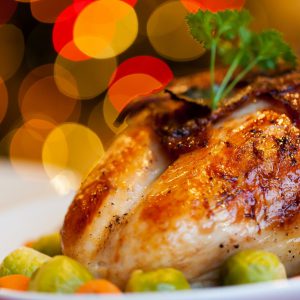
Photo credit:
www.Pexels.com (Creative Commons License)
According to the National Turkey Federation, 88% of American families eat turkey on Thanksgiving. That’s over 46 million turkeys! Served as the main dish, it is complemented by a variety of sweet and savory side dishes, many of which are family traditions made from recipes passed down through the generations.
Why do we eat turkey on Thanksgiving, anyway? Well, it’s kind of a funny story. While historians generally agree that turkey wasn’t eaten at the First Thanksgiving in Plymouth in 1621, it was well-documented that settlers often hunted wild turkeys as a source of protein, and subsequent celebrations often included turkey. After President Lincoln declared Thanksgiving a national holiday in 1863, turkey became a staple on many Thanksgiving tables.
When choosing a turkey, there are a few decisions to make. How many people will be eating? Will it be roasted, smoked, or deep-fried? Is frozen or fresh preferred?
When it comes to the proper size, a pound per person is a great rule of thumb. This includes the total weight of the bird, not just the meat. Also, the ratio of white meat to dark meat is about 7:3 (70% white meat, 30% dark), so if there are a lot of dark meat lovers around the table, additional thighs and drumsticks may need to be purchased.
Roasting is the most common way to cook a turkey. This method involves placing the turkey in a large roasting pan and cooking it in the oven slowly over several hours. The turkey is usually placed breast-side up in the pan and basted periodically to prevent drying. The lid or foil is also removed the last 30 to 45 minutes of roasting time to brown the skin and give the turkey that gorgeous presentation.
Vegetables such as potatoes, carrots, or Brussels sprouts may be added to the roasting pan to cook concurrently. For best results, roast the turkey at 325˚F for 15 minutes per pound. For example, a 15 pound turkey would take 3 hours and 45 minutes.
Smoked turkeys are usually fully cooked (read the label to be sure) and just need to be reheated. Keep in mind, smoking is done to impart flavor and does not increase the turkey’s shelf life. Follow the instructions on the package to properly reheat the turkey.
Deep-fried turkeys are submerged in very hot oil and cook more quickly than roasted turkeys. Turkeys can be deep fried in a very large stockpot or in a designated turkey fryer. Only use enough oil to cover the turkey. Too much oil can cause a fire or overflow when the turkey is added to the cooker.
To determine the amount of oil, place the turkey in the cooker and add enough water to cover the bird. Then remove the bird. The water line will indicate the level of oil needed to adequately fry the turkey. For best results, let the turkey warm to room temperature before frying, and fry the turkey for 3 minutes per pound plus 5 minutes per bird.
Remember, the size of the cooker will dictate the size of the turkey. The turkey should fit easily without being forced. Wedging a turkey into a cooker that is too small could cause uneven cooking, or worse, a fire.
As for frozen versus fresh, there is no difference in flavor. However, frozen turkeys can be purchased months in advance and kept frozen until needed. Fresh turkeys should be purchased no more than two days in advance for maximum safety and freshness.
The safest way to thaw a frozen turkey is in the refrigerator. This will take pre-planning. The general rule of thumb is 24 hours of refrigerator thawing per 5 pounds. For example, a 15 pound turkey should take 3 full days (72 hours) to thaw completely.
However the turkey is cooked this year, have a Happy Thanksgiving!

by Melanie Taylor | Oct 16, 2017

Make Halloween a fun and safe night for children and adults alike.
From candy to pumpkins to the costumes, Halloween is a fun-filled time for kids and adults alike. However, it can pose dangers. To help make this year’s trick-or-treat a safe and fun time, follow these simple safety tips compiled by the American Academy of Pediatrics.
CREATIVE COSTUMES:
Plan costumes that are bright and reflective. Make sure shoes fit well and costumes are short enough to prevent tripping, entanglement, or contact with flames.
Consider adding reflective tape or striping to costumes and trick-or-treat bags for greater visibility.
Because masks can limit or block eyesight, consider non-toxic makeup and decorative hats as safer alternatives. Hats should fit properly to prevent them from sliding over eyes. The makeup should be tested on a small patch of skin ahead of time to ensure there are no unpleasant allergies on the big night.
When shopping for costumes, wigs, and accessories, look for and purchase those with a label clearly indicating they are “flame resistant.”
If a sword, cane, or stick is a part of your child’s costume, make sure it is not sharp or long. A child may be easily hurt by the accessories if he/she stumbles or trips.
Do not use decorative contact lenses without an eye examination and a prescription from an eye care professional. While the packaging on decorative lenses will often make claims such as “one size fits all,” or “no need to see an eye specialist,” obtaining decorative contact lenses without a prescription is both dangerous and illegal. This can cause pain, inflammation, and serious eye disorders and infections, which may lead to permanent vision loss.
Review with children how to call 911 if they ever have an emergency or become lost.
PUMPKIN CARVING TIME:
Small children should never carve pumpkins. Children can draw a face with markers. Then adults can do the cutting.
Consider using a flashlight or glow stick instead of a candle to light your pumpkin. If you do use a candle, a votive candle is safest.
Candlelit pumpkins should be placed on a sturdy table, away from curtains and other flammable objects, and not on a porch or any path where visitors may pass close by. They should never be left unattended.
HOME SAFETY:
To keep homes safe for visiting trick-or-treaters, parents should remove from the porch and front yard anything a child could trip over such as garden hoses, toys, bikes, and lawn decorations.
Adults should check outdoor lights and replace burned-out bulbs.
Wet leaves and debris should be swept from sidewalks and steps.
Restrain pets so they do not jump on or bite a trick-or-treater.
TRICK-OR-TREAT TIME:
A responsible adult should always accompany young children during their neighborhood trick-or-treating.
Obtain flashlights with fresh batteries for all children and adults.
If your older children are going alone, plan and review the route that is acceptable to you. Agree on a specific time when they should return home.
Only go to homes with a porch light on and never enter a home or car for a treat.
Because pedestrian injuries are the most common injuries to children on Halloween, remind Trick-or-Treaters to:
- Stay in a group and communicate where they will be going.
- Remember reflective tape for costumes and trick-or-treat bags.
- Carry a cellphone for quick communication.
- Remain on well-lit streets and always use the sidewalk.
- If no sidewalk is available, walk at the far edge of the roadway facing traffic.
- Never cut across yards or use alleys.
- Only cross the street as a group in established crosswalks (as recognized by local custom). Never cross between parked cars or out of driveways.
- Do not assume the right of way. Motorists may have a hard time seeing Trick-or-Treaters.
- Just because one car stops does not mean others will!
- Law enforcement authorities should be notified immediately of any suspicious or unlawful activity.
HEALTHY HALLOWEEN TIPS:
A good, healthy dinner prior to parties and trick-or-treating will discourage children from filling up on Halloween treats.
Consider purchasing non-food treats for those who visit your home, such as coloring books, stickers, or pens and pencils.
Wait until children are home to sort and check treats. Though tampering is rare, a responsible adult should closely examine all treats and throw away any spoiled, unwrapped or suspicious items.
Try to ration treats for the days and weeks following Halloween to prevent overindulging, which will lead to a stomachache and ruin the night’s fun.
Make sure the Halloween night is fun and safe with the suggested tips above. These tips will help guarantee you all a ghoulishly good time.
Source: American Academy of Pediatrics
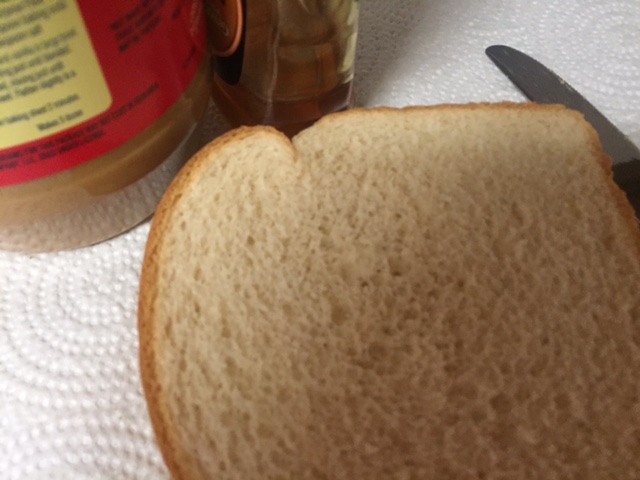
by Kendra Hughson | Aug 16, 2017
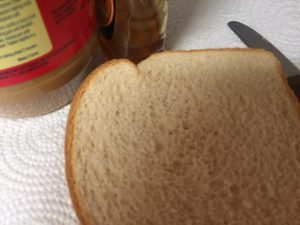
Jazz up traditional peanut butter sandwiches with raisins or carrot straws.
Now that school is back in session, are your struggling to find healthy and safe lunches to pack? Do you cringe with every peanut butter and jelly sandwich you make? If you are like me, finding healthy lunch time meals that are packed with nutrition, offer some variety, and won’t end up in the trash requires planning, creativity, and lots of energy!
- Get children involved! Even young school-age children can help make their own lunch. Give children healthy choices and let them decide lunch menus. Children may be more willing to eat the food you pack if they have been involved in the process.
- Dunk it and dip it. Children love finger foods they can dip. Serve raw vegetables with hummus or fresh fruit with yogurt.
- Offer some “fun foods.” Let children choose some low-calorie fun foods. Healthy or low-calorie options for the sweet or crunchy tooth include pretzels, plain popcorn, mini rice cakes, low-fat pudding, a miniature chocolate bar, or a rice crispy treat.
- Jazz up boring favorites. Peanut butter and jelly sandwiches are a nutritious favorite. Liven them up with carrot straws or raisins. Add color and nutrition to sandwiches with lettuce, tomato, or sliced vegetables.
- Keep lunches safe. Make sandwiches the night before and freeze them. Freeze juice boxes or water bottles to keep foods cool and for a cool lunchtime beverage. Experiment to be sure there is enough time before lunch for the items to thaw.
- Re-think leftovers. Even if children don’t have access to a microwave to reheat food from last night’s dinner, some leftovers work for lunch, too. Try cold pizza, meat sliced for a sandwich, or pasta salad.
- Skip the fuss and sign up for the National School Lunch Program. While some schools may offer free and reduced-price lunches to eligible families, the school lunch program is for everyone. School lunches provide low cost, balanced meals that follow USDA dietary guidelines. Take a break from packing lunch and check out your school’s lunch menu.
Turkey Rolls:
2 flour tortillas
2 tsp mayonnaise
2 slices thinly sliced deli turkey
½ cup shredded lettuce
2 Tbsp shredded cheese, any type
Lay out tortillas. Spread with mayonnaise. Layer turkey slice, lettuce and cheese onto tortillas. Roll up and wrap. Makes 2 servings.
One serving provides 218 calories, 9 g total fat, 20 g carbohydrate and 14 g protein.
Exchanges – 1 bread, 2 meats, 2 fats.
Recipe source: Janis G. Hunter, HGIC Nutrition Specialist, and Katherine L. Cason, Professor, Department of Food, Nutrition, and Packaging Sciences, Clemson University, New 08/08. Revised 09/11. Image added 8/15. HGIC 4114
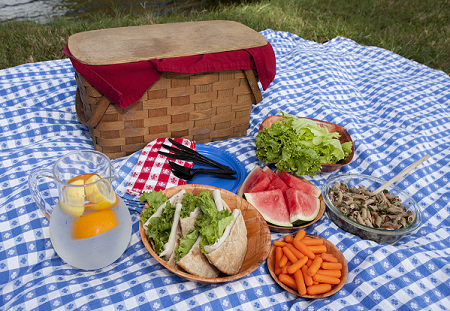
by Samantha Kennedy | Jun 27, 2017
 There are few things more iconic during summer than a picnic. There’s just something fresh and fun about sharing a meal in the park or at the beach with family and friends. But just because you’re enjoying the warm, gentle breeze doesn’t mean you should throw caution to the wind. By following a few simple food safety tips, you can ensure that your perfectly planned picnic doesn’t make you sick.
There are few things more iconic during summer than a picnic. There’s just something fresh and fun about sharing a meal in the park or at the beach with family and friends. But just because you’re enjoying the warm, gentle breeze doesn’t mean you should throw caution to the wind. By following a few simple food safety tips, you can ensure that your perfectly planned picnic doesn’t make you sick.
Planning it out. Not all foods are picnic-appropriate. Anything that requires a lot of perishable ingredients and/or a lot of preparation should be avoided. Stick with foods that require little or no cooking and that contain just a few ingredients. Foods such as fruits and vegetables (especially whole ones), hard cheeses, peanut butter and jelly, cereal, bread, and crackers are ideal picnic items. Anything made with commercially processed custard or mayonnaise will stay safe as long as they are kept cold.
Packing it up. Use a cooler, if possible, and store cold foods together so they can help each other stay colder longer. Use ice or frozen gel packs to help keep foods cold. Pack foods directly from the refrigerator into the cooler; don’t leave them sitting out before packing. Store ready-to-eat foods separately from raw meats. If packing up hot foods, be sure to keep them in a thermos or other insulated dish. DO NOT store them in the same container as the cold foods. Paper towels, disposable utensils, and a food thermometer are ideal picnic accessories. Remember, keep cold foods below 41 degrees F and hot foods above 135 degrees F. Do your best to keep the cooler away from direct sunlight by storing it in the shade and be sure to replenish the ice and/or frozen gel packs when they melt. Consider packing drinks in a separate cooler, as they are consumed more frequently; this will reduce the exposure of food items to warm air until you’re ready to eat.
Preparing the feast. All food items should be kept at the proper temperature at all times. When cooking raw meats, use separate plates for the raw and cooked products and clean and sanitize utensils between uses. Cook meat to the proper recommended internal temperature to ensure doneness and safety. Click here for a list of recommended internal cooking temperatures.
Presenting the bounty. Discard any perishable foods that have been left out for longer than two hours. In really hot weather (generally above 90 degrees F), foods should not be left out longer than one hour. Keep food protected in storage containers such as coolers and lidded dishes to minimize contamination from flies and other pests. Serve small portions of food at a time and keep the rest in the cooler.
Picnics are an important part of summer and with just a little bit of planning and a few useful tips and tools, they can be safe and delicious for everyone!
Source: Beaugh, Kristina. “Checklist for the Perfect Summer Picnic,” Foodsafety.gov blog, June 16, 2015. URL: https://www.foodsafety.gov/blog/2015/06/picnic.html.
by Dorothy C. Lee | Jun 11, 2017
June is National Dairy Month. National Dairy month was first celebrated in 1937 to encourage Americans to drink more milk.
Milk and dairy products comprise a diverse group of foods from fluid milks, fermented milk products, and over 500 cheeses.
Generations of American children have grown up hearing the same parental advice, “Drink your milk…..milk builds strong bones and teeth.”
Milk has long been associated with good health, making it one of the heathiest beverages consumed in the United States. Current Dietary Guidelines recommend daily consumption of dairy for greatest impact. The body requires essential nutrients to maintain optimal health. Milk and dairy products are rich in many of these nutrients. Milk and dairy products contain calcium, vitamins A, D, B12, and high quality protein. The body absorbs calcium with the aid of vitamin D, both of which are found in fluid dairy products. Milk, whole, low fat, and skim, are homogenized and vitamin D fortified.
The amount of consumption from the dairy food group depends on age. Generally one cup of milk, yogurt, or one and a half ounces of cheese is considered a serving from the dairy group.
The cost of milk and dairy products varies. Careful selection can result in substantial savings. Milk generally is less expensive as a source of calcium than other dairy products.
Effective shopping skills depend on understanding and using information on the label including nutrition facts, product date, contents and ingredient statements. Usually larger containers, such as half gallon to a gallon cost less than single quarts. Compare the cost of the number of servings.
Milk and dairy products are highly perishable, so careful handling and storage to prevent spoilage, preserve flavor and retain nutritional uniformity is needed.
Florida regulations call for uniform standards for dating milk and requires all dairy processors to label milk and dairy product containers with the last date the product can be offered for sale. The date on the container does not mean that the milk will be spoiled on that date; it indicates that the milk should not be sold beyond that date. This is to insure a reasonable shelf life in your refrigerator after it is purchased. The quality and flavor are still dependent upon careful handling and storage. Remember, milk and dairy products are highly perishable and should be kept cold.
In recent years many kinds of alterative milk products have appeared in the market place. In choosing a dairy milk or dairy alternative you should be aware of the different alternative milk products available and what makes them different. With so many kinds of milk and milk alternatives on the market, reading the labels on containers to recognize differences in the contents is well worth while. Here is information on some of the more popular forms of milk alternatives now available and an explanation of some special terms you may find on labels and facts that may help in buying.
-
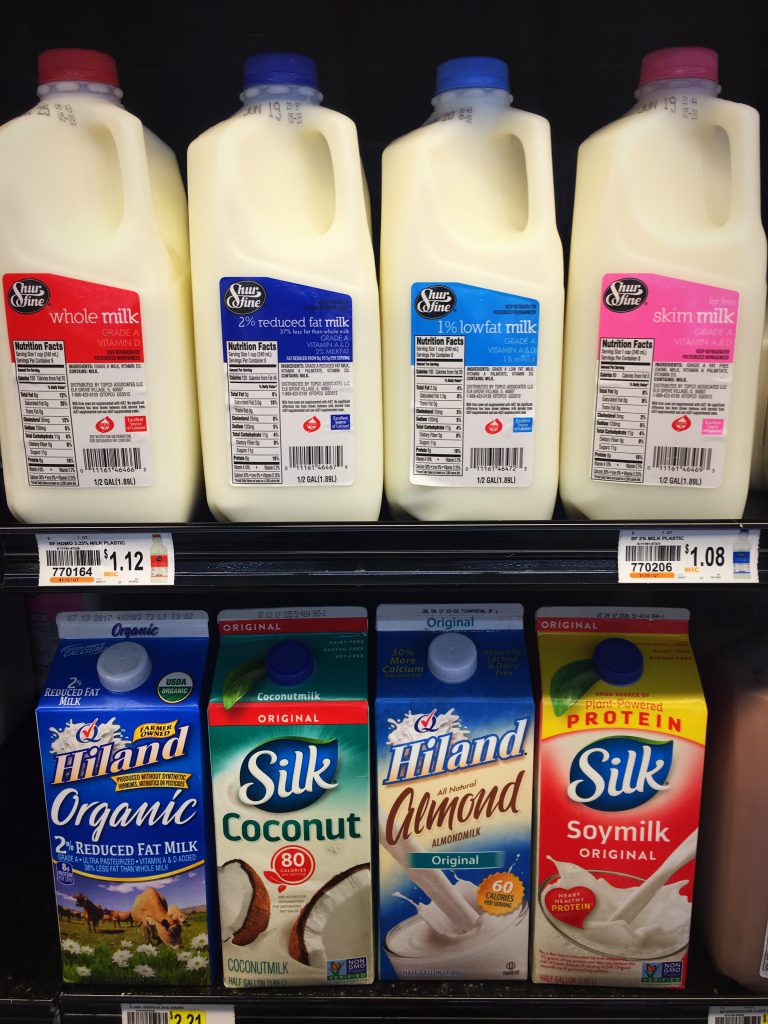
Variety of milks Picture by Wendy Meredith
Almond
- Low-fat
- 40 calories
- 1 gram protein
- Low in protein or calcium content. Nutty flavor.
- Coconut
- 420 calories per cup
- 3 grams protein
- 45 grams fat
- High in fat content.
- Hemp
- Made from hemp seeds
- Contains 10 essential amino acids
- 80-140 calories per cup
- 3 grams protein
- Grassy flavor. Tends to separate when added to hot beverages.
- Rice
- 130 calories per cup
- 1 gram protein
- 2 grams fat
- Low in fat and protein content. Higher in carbohydrates.
- Soy
- 110 -130 calories per cup
- 7-11 grams protein
- 4 grams fat
- Higher in protein content. Thick texture often taste.
There are many ways to add milk into meals. Many people find milk refreshing and never tire of drinking it plain. However, cooked foods and other prepared foods offer many additional ways to add more milk into daily food, always with much added nutritive value and often extra dividends in flavor. Use milk instead of water when preparing cooking cereal, or add milk when preparing soups, mashed potatoes, custards sauces and other cooked foods. Beverages made with milk or milk products fit into meals and snacks and add extra nutritive values to daily fluid intake.
June is National Dairy Month, but milk is needed for good health every day of the year.
References;
https://www.ams.usda.gov/about-ams/programs-offices/dairy-program
https://www.choosemyplate.gov/
https://health.gov/DietaryGuidelines/
For further information, contact:
Dorothy C. Lee, C.F.C.S.
UF/IFAS Extension Escambia County
3740 Stefani Road
Cantonment, FL 32533-7792
(850) 475-5230








